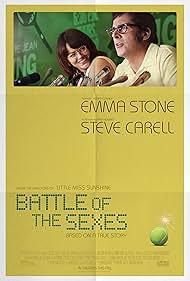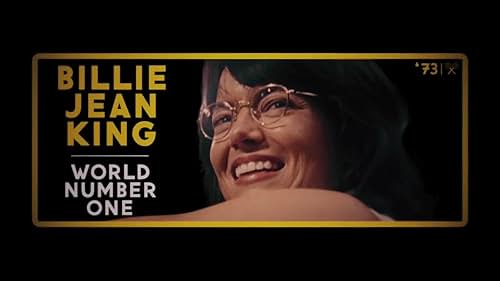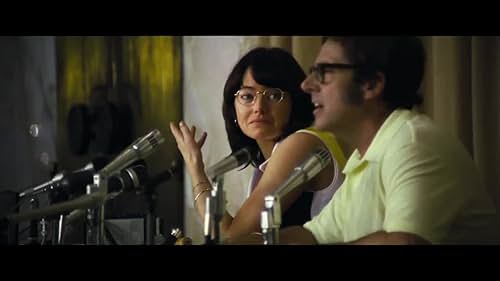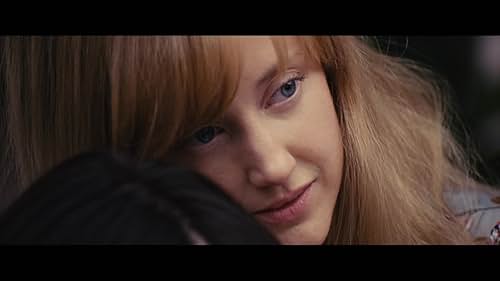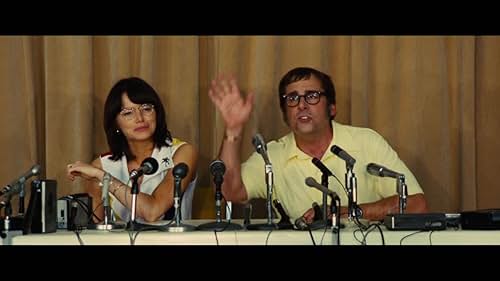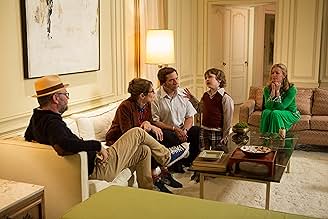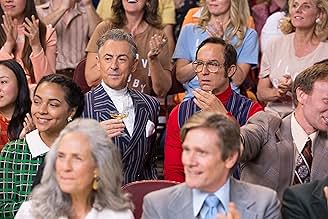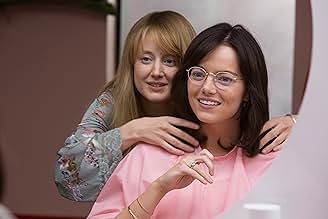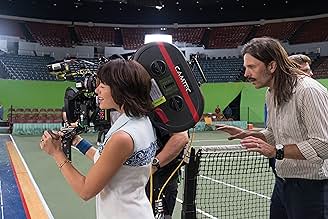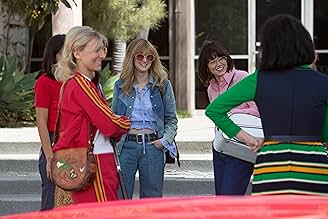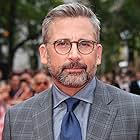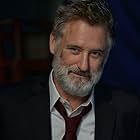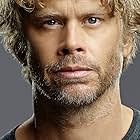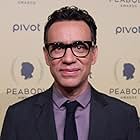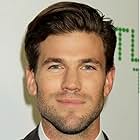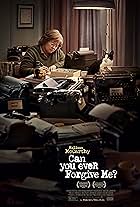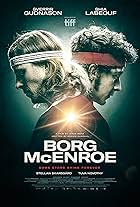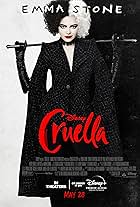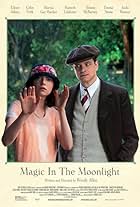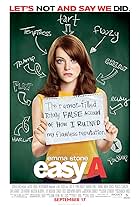The true story of the 1973 tennis match between World number one Billie Jean King and ex-champ and serial hustler Bobby Riggs.The true story of the 1973 tennis match between World number one Billie Jean King and ex-champ and serial hustler Bobby Riggs.The true story of the 1973 tennis match between World number one Billie Jean King and ex-champ and serial hustler Bobby Riggs.
- Awards
- 3 wins & 24 nominations
- Directors
- Writer
- All cast & crew
- Production, box office & more at IMDbPro
Storyline
Did you know
- TriviaIn 1973, Billie Jean King was 29 and Bobby Riggs was 55. At the time of filming, Emma Stone was 28 and Steve Carell was 54.
- GoofsWhile Billie Jean King was having an intimate relationship with Marilyn Barnett during the "Battle of the Sexes", Barnett was not a hairdresser King met by chance. Barnett was King's secretary.
- Quotes
Billie Jean King: I'm not saying women are better. I've never said that. I'm saying we deserve some respect.
- Crazy creditsThe Fox Searchlight Pictures and TSG Entertainment logos are redone in period-appropriate styles.
- ConnectionsEdited from Bobby Riggs vs. Billie Jean King: Tennis Battle of the Sexes (1973)
- SoundtracksMovie House Theme
Written and Performed by Nicholas Britell
Featured review
The themes presented in this film are still relevant and have merit. With that said, I want to add that ever since Ibsen wrote "A Doll's House," it's very rare to get a film (or play for that matter) that is charged with the theme of gender equality and presents it in a way that truly resonates. What do I mean? In films that aim to give a message or present an issues, such as when the writer wants to say something about the relevant society, more often than not, the writer portrays those characters in simple categorizations of good and bad. That may work in a superhero film, but in a piece of realism, where character development and relationships are key elements to the storytelling, simple good and bad just won't do. That's my issue with this film. The screenplay simplifies a few integral characters too much, in favor of hoisting up its protagonist.
To get this out of the way, the performances are fantastic. Emma Stone and Steve Carell lead the cast well, and the cast doesn't have a weak link in it. In particular, a lot of credit has to be given to Steve Carell. He took a character that was underwritten and perhaps even misrepresented and makes him sympathetic and someone to root for. Andrea Riseborough also delivers a very affecting performance and really gives us some great scene work with Emma Stone.
The directing is swift, well paced and well filmed. Kudos to the cinematographer who really has a wonderful grasp on stillness to promote an essential moment and exerts great uses of soft and hard focus to portray dramatic moments and internalize character feelings. The editing also deserves a shout out for some wonderful pacing and really effectively switching between the grainy, 70s like cinematography and more clear cinematography.
Now, back to the screenplay. What made and still makes "A Doll's House" the ultimate gender-equality script is that every character can be sympathized with. We learn more about the human condition and evils of society, rather than placing blame and anger on individual groups. There are only two men that can be rooted for without hesitation and that's our protagonist's husband and father. Every other guy is completely unlikable and has no arc, and Steve Carell's character can be questioned. Carell's character, who is a vital part of this story, isn't written very well or thoroughly. It's always hard to have two protagonists in a film, especially at a reasonable and well paced time. Carell's character is both an antagonist and protagonist or, at least attempts to be so. Carell's character opposes Emma Stone's. It's a man versus women ordeal and their tennis match is the crisis and climax of the film. But, here's the issue. Carell's character is NOT the antagonist. It's society! So why is Carell's character's standing within the realm of the film so questionable? Why doesn't he get his own arc? Every major character in "A Doll's House" takes a journey. That's what makes us empathize with them and come away disliking their society, and not the products of that society. The same would work with this film. But instead, there is a co- protagonist / antagonist that is not written for people to care about or even empathize with. He gets no arc, no change. He's unaffected. He may as well have been a smaller part.
Why is this an issue? Because Emma Stone's character is a catalyst. She's the driving force and vehicle used within the film to represent the affects of an unjust era and to showcase the positive effects that a change in this society would have. Unfortunately, because Carell's character and the real antagonists (the sexists who sit atop the societal ladder) don't change, because we only see them as unlikable, this story turns into something simple and ultimately un-fulfilling. Stone's character merely wins the battle within the film and we come away knowing that and are momentarily happy. However, that soon goes away, which makes this entertaining dramedy perhaps a little forgettable. Had the writing been more substantial and caring to all its characters, and forgiving to all its characters and condemned society instead, we'd come away with a more profound understanding of where issues lie and are issued from. That's a memorable film. I suppose the cinematic world is still chasing Ibsen.
I give this film 3 out of 5 stars for its entertainment value and performances and recommend it for ages 13 to 18. Reviewed by Willie J., KIDS FIRST! Film Critic.
To get this out of the way, the performances are fantastic. Emma Stone and Steve Carell lead the cast well, and the cast doesn't have a weak link in it. In particular, a lot of credit has to be given to Steve Carell. He took a character that was underwritten and perhaps even misrepresented and makes him sympathetic and someone to root for. Andrea Riseborough also delivers a very affecting performance and really gives us some great scene work with Emma Stone.
The directing is swift, well paced and well filmed. Kudos to the cinematographer who really has a wonderful grasp on stillness to promote an essential moment and exerts great uses of soft and hard focus to portray dramatic moments and internalize character feelings. The editing also deserves a shout out for some wonderful pacing and really effectively switching between the grainy, 70s like cinematography and more clear cinematography.
Now, back to the screenplay. What made and still makes "A Doll's House" the ultimate gender-equality script is that every character can be sympathized with. We learn more about the human condition and evils of society, rather than placing blame and anger on individual groups. There are only two men that can be rooted for without hesitation and that's our protagonist's husband and father. Every other guy is completely unlikable and has no arc, and Steve Carell's character can be questioned. Carell's character, who is a vital part of this story, isn't written very well or thoroughly. It's always hard to have two protagonists in a film, especially at a reasonable and well paced time. Carell's character is both an antagonist and protagonist or, at least attempts to be so. Carell's character opposes Emma Stone's. It's a man versus women ordeal and their tennis match is the crisis and climax of the film. But, here's the issue. Carell's character is NOT the antagonist. It's society! So why is Carell's character's standing within the realm of the film so questionable? Why doesn't he get his own arc? Every major character in "A Doll's House" takes a journey. That's what makes us empathize with them and come away disliking their society, and not the products of that society. The same would work with this film. But instead, there is a co- protagonist / antagonist that is not written for people to care about or even empathize with. He gets no arc, no change. He's unaffected. He may as well have been a smaller part.
Why is this an issue? Because Emma Stone's character is a catalyst. She's the driving force and vehicle used within the film to represent the affects of an unjust era and to showcase the positive effects that a change in this society would have. Unfortunately, because Carell's character and the real antagonists (the sexists who sit atop the societal ladder) don't change, because we only see them as unlikable, this story turns into something simple and ultimately un-fulfilling. Stone's character merely wins the battle within the film and we come away knowing that and are momentarily happy. However, that soon goes away, which makes this entertaining dramedy perhaps a little forgettable. Had the writing been more substantial and caring to all its characters, and forgiving to all its characters and condemned society instead, we'd come away with a more profound understanding of where issues lie and are issued from. That's a memorable film. I suppose the cinematic world is still chasing Ibsen.
I give this film 3 out of 5 stars for its entertainment value and performances and recommend it for ages 13 to 18. Reviewed by Willie J., KIDS FIRST! Film Critic.
- How long is Battle of the Sexes?Powered by Alexa
Details
- Release date
- Countries of origin
- Official sites
- Language
- Also known as
- The Battle of the Sexes
- Filming locations
- Westin Bonaventure Hotel & Suites - 404 S. Figueroa Street, Downtown, Los Angeles, California, USA(Hotel where Marylin & Larry run into each other in the elevator)
- Production companies
- See more company credits at IMDbPro
Box office
- Budget
- $25,000,000 (estimated)
- Gross US & Canada
- $12,638,526
- Opening weekend US & Canada
- $518,332
- Sep 24, 2017
- Gross worldwide
- $18,598,607
- Runtime2 hours 1 minute
- Color
- Sound mix
- Aspect ratio
- 2.39 : 1
Contribute to this page
Suggest an edit or add missing content

